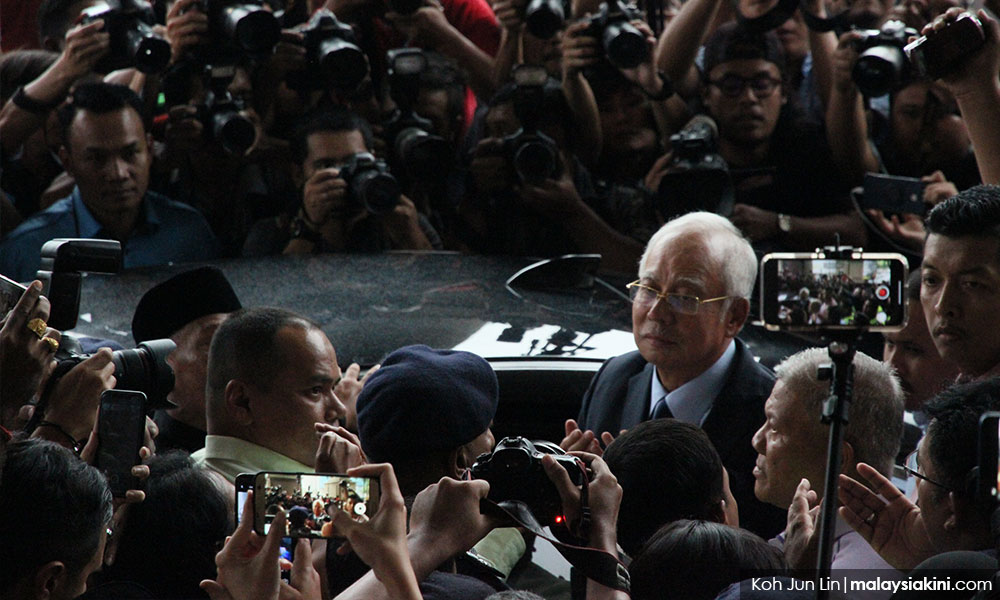
KINIGUIDE | Former prime minister Najib Abdul Razak yesterday claimed trial to 25 charges, all linked to 1MDB and the RM2.6 billion donation scandal.
Twenty-one of the charges were brought by the police under the Anti-Money Laundering, Anti-Terrorism Financing and Proceeds of Unlawful Activities Act 2001 (AMLATF).
The remaining four were brought by the MACC and were for abuse of power.
In 2016, then attorney-general Mohamed Apandi Ali had cleared Najib of all wrongdoing in regards to the scandal.
What is the RM2.6 billion scandal about?
The RM2.6 billion scandal refers to US$681 million that was transferred to Najib's personal bank account in March and April 2013.
The sum was at the time was valued at RM2.08 billion. However, when the scandal first surfaced in 2015, the exchange rate then put the figure at RM2.6 billion.
The funds were allegedly meant to finance BN's campaign for the 13th general election.
Najib has claimed that the funds were a donation from the Saudi royal family.
However, prosecutors claim the monies had been misappropriated from 1MDB through the Tanore Finance Corporation.
What is the Tanore Finance Corporation?
Tanore is alleged to have transferred RM2.08 billion to Najib and later received back RM1.53 billion from the ex-premier.
According to the US Department of Justice (DOJ), Tanore is owned by Eric Tan Kim Loong, a close associate of alleged 1MDB mastermind Jho Low, who had also used his name as an alias.
Najib, however, claimed Tanore is owned by the Saudi royal family and has previously produced three letters by one "Saud Abdulaziz Al Saud". In one of the letters, the author declared that Tanore belonged to the prince.
What is the prosecution alleging against Najib?
The 21 charges of money-laundering against Najib pertain to all transactions involving the so-called donation.
Najib is alleged to have received in his personal accounts RM2.08 billion in nine tranches from Tanore through the Falcon Bank in Singapore.
He is also being charged for abusing his power as prime minister, finance minister and 1MDB Board of Advisors chairperson to obtain gratification of RM2.28 billion from 1MDB, which includes the RM2.08 billion.
What are the specifics of the charges?
Section 4(1) of the AMLATF - the charge under this section of the law focuses on alleged money-laundering whereby Najib received, spent and transferred the RM2.08 billion.
He is alleged to have received the sum in nine tranches between March 22 until April 10, 2013. He is then alleged to have returned RM1.53 billion to Tanore in August 2013.
In that same period, Najib is accused of having paid five recipients, namely Umno (RM20 million); Batu Kawan Umno (RM100,000); Lim Soon Peng (RM246,000); ORB Solutions Sdn Bhd (RM2 million) and RM303,000 to Semarak Consortium Sdn Bhd.
The remaining RM12.4 million was then transferred into another AmBank account of his.
Section 4(1) of the AMLATF also sets out the punishment for money laundering. Under the law, those convicted can be jailed for up to 15 years.
They are also liable to a fine of not less than five times the value of proceeds gained from the money-laundering, or RM5 million, whichever is higher.
Section 23 of the MACC Act - Najib is accused of having abused his position as prime minister, finance minister and as 1MDB Board of Advisors chairperson to receive RM2.28 billion in gratification.
One of the charges details how Najib had received the RM2.08 billion.
The ex-prime minister is said to have done this by allowing 1MDB to enter into a joint venture with Aabar Investment PJS and subsequently issuing a letter of support for 1MDB to issue a US$3 billion bond.
Najib is also accused of having abused his power and influence over the government and 1MDB to obtain gratifications of RM60 million, RM90.9 million and RM49.9 million on three separate occasions.
Section 23(1) of the MACC Act states: "Any officer of a public body who uses his office or position for any gratification whether for himself, his relative or associate, commits an offence."
If found guilty, Najib will be sentenced under Section 24(1) of the same act and is liable to a prison term not exceeding 20 years and a fine of not less than five times the sum or value of the gratification. -Mkini



No comments:
Post a Comment
Note: Only a member of this blog may post a comment.